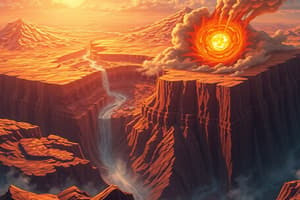Podcast
Questions and Answers
What is the primary cause of the ground shaking during an earthquake?
What is the primary cause of the ground shaking during an earthquake?
- The pressure building up in the fault
- The friction between the footwall and hanging wall
- The sudden release of energy as the rocks slip (correct)
- The movement of the hanging wall
What is the term for the block of rock that forms the lower half of a fault?
What is the term for the block of rock that forms the lower half of a fault?
- Focus
- Epicenter
- Hanging wall
- Footwall (correct)
What is the name of the scale that measures the amount of energy released during an earthquake?
What is the name of the scale that measures the amount of energy released during an earthquake?
- MMs scale
- Mercalli scale
- Richter scale (correct)
- Seismic scale
What type of fault is characterized by the hanging wall moving up?
What type of fault is characterized by the hanging wall moving up?
What is the purpose of a seismograph?
What is the purpose of a seismograph?
What is the term for a strong circular weather system that forms over the ocean, characterized by strong winds and rainfall?
What is the term for a strong circular weather system that forms over the ocean, characterized by strong winds and rainfall?
What is the condition that is necessary for the formation of typhoons?
What is the condition that is necessary for the formation of typhoons?
What is the term for the system of interconnected faults that run north to south in the Philippines?
What is the term for the system of interconnected faults that run north to south in the Philippines?
What is the scale that calculates the strength of an earthquake based on the size of the fault and the amount of movement along the fault?
What is the scale that calculates the strength of an earthquake based on the size of the fault and the amount of movement along the fault?
What is the term for an earthquake that occurs under the ocean?
What is the term for an earthquake that occurs under the ocean?
What is the name of the region where the wind from the northern and southern hemispheres meet?
What is the name of the region where the wind from the northern and southern hemispheres meet?
What is the warning signal for a tropical cyclone with winds of 118 to 184 km/h?
What is the warning signal for a tropical cyclone with winds of 118 to 184 km/h?
Flashcards are hidden until you start studying
Study Notes
Earthquakes and Faults
- A fault is a break in the Earth's crust where significant movement takes place
- Rocks in a fault are stuck together due to friction, but slip when pressure builds up
- When a fault slips, the ground shakes, and this is what causes an earthquake
- The focus/hypocenter is the spot where the fault begins to slip or move
- The epicenter is the spot above the focus
- The footwall is the block of rock that forms the lower half of a fault, always below the fault line
- The hanging wall is the rock that forms the upper half of a fault, always above the fault line
- There are different types of faults, including dip-slip faults, where blocks have shifted vertically, and strike-slip faults, which develop in mid-oceanic ridges
- Normal faults occur when the hanging wall slides down, and reverse faults occur when the hanging wall moves up
- The Philippine fault system and trenches are a system of interconnected faults that run north to south
Earthquake Intensity and Magnitude
- The Richter scale measures earthquake magnitude, with each level indicating 10 times the amount of shaking and 33 times the amount of energy
- A seismograph records vibrations of an earthquake, producing a seismogram
- The Moment Magnitude Scale (MMS) calculates the strength of an earthquake based on the size of the fault, amount of movement along the fault, and rigidness of the rocks
- Intensity measures the strength of shaking and amount of energy released, often using the Mercalli scale
Effects of Earthquakes and Preparedness
- Earthquakes can cause fires, gas leaks, floods, polluted water supply, and damage to bridges and roads
- Earthquake preparedness involves knowing what to do before, during, and after an earthquake
Typhoons
- A typhoon is a strong circular weather system with wind and rainfall, moving counterclockwise
- Hurricanes are equivalent to typhoons in the Atlantic Ocean and the Pacific Ocean
- The Intertropical Convergence Zone (ITCZ) is a region where winds from the northern and southern hemispheres meet
- Conditions that favor typhoon formation include ocean water temperatures above 26.5°C, the presence of ITCZ, low-pressure areas, and light winds
- Typhoons are classified as tropical depressions, tropical storms, severe tropical storms, typhoons, and super typhoons based on wind speed
Tracking and Preparing for Typhoons
- Tropical cyclones are strong if they have warm water and low pressure, and weak if they have land masses and high-pressure areas
- Tracking a tropical cyclone involves knowing its general direction, which is often northwest due to large-scale winds
- The anatomy of a typhoon includes the eye, eyewall, and rain bands
- Typhoon preparedness involves knowing the risks of storm surges, strong winds, extreme rainfall, landslides, and tornadoes
- Tropical cyclone warning signals include Signal 01, Signal 02, Signal 03, Signal 04, and Signal 05, which correspond to increasing wind speeds and danger levels
Studying That Suits You
Use AI to generate personalized quizzes and flashcards to suit your learning preferences.




